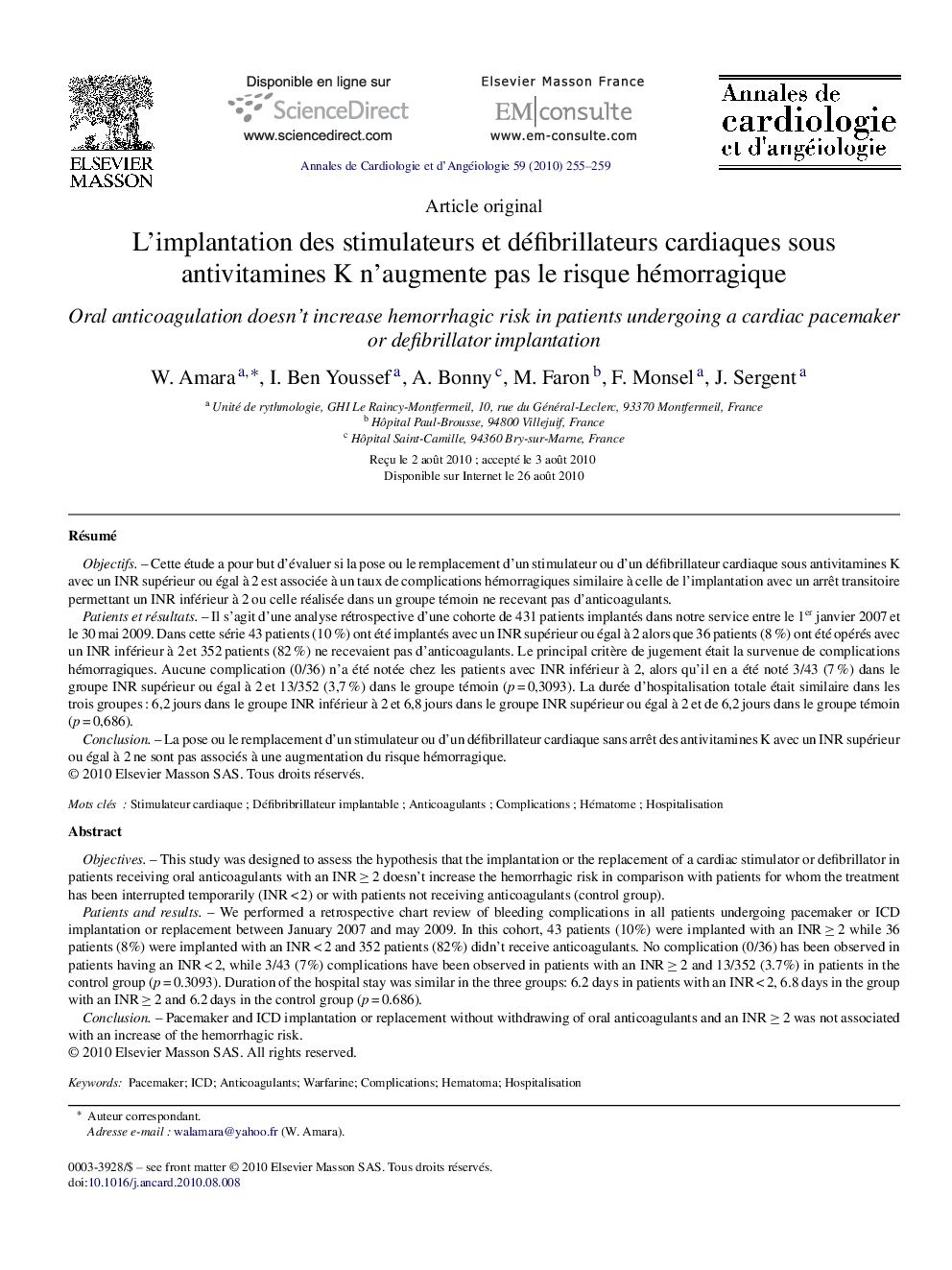| Article ID | Journal | Published Year | Pages | File Type |
|---|---|---|---|---|
| 2869253 | Annales de Cardiologie et d'Angéiologie | 2010 | 5 Pages |
RésuméObjectifsCette étude a pour but d’évaluer si la pose ou le remplacement d’un stimulateur ou d’un défibrillateur cardiaque sous antivitamines K avec un INR supérieur ou égal à 2 est associée à un taux de complications hémorragiques similaire à celle de l’implantation avec un arrêt transitoire permettant un INR inférieur à 2 ou celle réalisée dans un groupe témoin ne recevant pas d’anticoagulants.Patients et résultatsIl s’agit d’une analyse rétrospective d’une cohorte de 431 patients implantés dans notre service entre le 1er janvier 2007 et le 30 mai 2009. Dans cette série 43 patients (10 %) ont été implantés avec un INR supérieur ou égal à 2 alors que 36 patients (8 %) ont été opérés avec un INR inférieur à 2 et 352 patients (82 %) ne recevaient pas d’anticoagulants. Le principal critère de jugement était la survenue de complications hémorragiques. Aucune complication (0/36) n’a été notée chez les patients avec INR inférieur à 2, alors qu’il en a été noté 3/43 (7 %) dans le groupe INR supérieur ou égal à 2 et 13/352 (3,7 %) dans le groupe témoin (p = 0,3093). La durée d’hospitalisation totale était similaire dans les trois groupes : 6,2 jours dans le groupe INR inférieur à 2 et 6,8 jours dans le groupe INR supérieur ou égal à 2 et de 6,2 jours dans le groupe témoin (p = 0,686).ConclusionLa pose ou le remplacement d’un stimulateur ou d’un défibrillateur cardiaque sans arrêt des antivitamines K avec un INR supérieur ou égal à 2 ne sont pas associés à une augmentation du risque hémorragique.
ObjectivesThis study was designed to assess the hypothesis that the implantation or the replacement of a cardiac stimulator or defibrillator in patients receiving oral anticoagulants with an INR ≥ 2 doesn’t increase the hemorrhagic risk in comparison with patients for whom the treatment has been interrupted temporarily (INR < 2) or with patients not receiving anticoagulants (control group).Patients and resultsWe performed a retrospective chart review of bleeding complications in all patients undergoing pacemaker or ICD implantation or replacement between January 2007 and may 2009. In this cohort, 43 patients (10%) were implanted with an INR ≥ 2 while 36 patients (8%) were implanted with an INR < 2 and 352 patients (82%) didn’t receive anticoagulants. No complication (0/36) has been observed in patients having an INR < 2, while 3/43 (7%) complications have been observed in patients with an INR ≥ 2 and 13/352 (3.7%) in patients in the control group (p = 0.3093). Duration of the hospital stay was similar in the three groups: 6.2 days in patients with an INR < 2, 6.8 days in the group with an INR ≥ 2 and 6.2 days in the control group (p = 0.686).ConclusionPacemaker and ICD implantation or replacement without withdrawing of oral anticoagulants and an INR ≥ 2 was not associated with an increase of the hemorrhagic risk.
